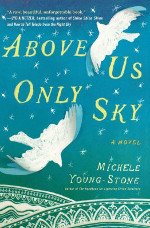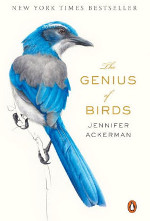Birds of a Feather | The Reader's Shelf
The brilliance of birds has become a recent topic in literary and cultural conversation. Notable nonfiction works explore just how intelligent birds are, while novelists use them for any number of devices.
 Our feathered friends can never be
Our feathered friends can never be  referred to as “bird brains” again after reading Jennifer Ackerman’s lively The Genius of Birds (Penguin. 2017. ISBN 9780399563126. pap. $17; ebk. ISBN 9781101980842). Ackerman presents an amazing account—supported by reams of scientific data—proving previous simplistic views of avian creatures woefully wrong. Whether illustrating the tool-making capacity of crows, investigating the architecture of seduction created by male bowerbirds, or detailing the mastery of nutcrackers’ elaborate memory games (they remember the locations of more than 30,000 seeds), this bird’s-eye view investigation reminds us, as Aesop indicated, “it is not only fine feathers that make fine birds.”
referred to as “bird brains” again after reading Jennifer Ackerman’s lively The Genius of Birds (Penguin. 2017. ISBN 9780399563126. pap. $17; ebk. ISBN 9781101980842). Ackerman presents an amazing account—supported by reams of scientific data—proving previous simplistic views of avian creatures woefully wrong. Whether illustrating the tool-making capacity of crows, investigating the architecture of seduction created by male bowerbirds, or detailing the mastery of nutcrackers’ elaborate memory games (they remember the locations of more than 30,000 seeds), this bird’s-eye view investigation reminds us, as Aesop indicated, “it is not only fine feathers that make fine birds.”
A 19th-century pharmacist, fascinated by Shakespeare’s catalog of birds—including the starling—introduced the aggressive, trouble-making bird to North America. Starlings are hated and considered a nuisance by some—a fact that Lyanda Lynn Haupt became aware of after adopting her own, Carmen, while researching Mozart’s Starling (Little, Brown. 2017. ISBN 9780316370899. $27; ebk. ISBN 9780316370875). Amadeus Mozart (1756–91) also found one of these birds particularly endearing. A champion at mimicry, his pet Star became the composer’s faithful muse; Haupt and Carmen similarly develop a strong bond. With winning style, Haupt parallels Mozart and Star’s relationship with Carmen and hers in this combination memoir, history, and avian primer.
Graduate student Nathan Lochmueller, the protagonist of Brian Kimberling’s Snapper (Vintage. 2014. ISBN 9780345803368. pap. $15; ebk. ISBN 9780307908063), is researching songbirds in rural Indiana. The story sees Nathan learning about Acadian flycatchers, wood thrushes, summer tanagers, and more, all the while searching for the meaning of life. Anecdotal, interconnected tales tell of Nathan’s myriad adventures, on drives in Gypsy Moth, his sparkly painted pickup truck, and in and out of his worshipful attachment to the elusive Lola. His experience with the eponymous Snapper, a snapping turtle who loves nibbling thumbs, enriches the narrative. Told with warmth and a wry sensibility, this love letter to the Hoosier State is a soaring adventure.
Jim Harrison’s The English Major (Grove: Atlantic. 2009. ISBN 9780802144140. pap. $14; ebk. ISBN 9781555848293) has sixtysomething Cliff also seeking life’s meaning. After his marriage crumbles, he abandons his Michigan hometown and hits the road, enhancing his appreciation of the American landscape and delighting in each state’s bird (he has a plan to rename every one—after all, Reuben is clearly a more fitting name for the robin, while the brown thrasher should become Beige Delarosa). His restorative meander morphs into a journey of epic proportions as he encounters a former student from long ago in Minnesota, joins up with an eccentric snake-loving pal in Arizona, and reconnects with his movie-producer son in San Francisco. It is a quixotic trek, penned with wit and verve.
Michele Young-Stone blends historical fiction and magic realism in her wonderfully wrought Above Us Only Sky (S. & S. 2016. ISBN 9781451657685. pap. $16; ebk. ISBN 9781451657692), which spans the violence and mayhem of the 1863 January Uprising in Eastern Europe through the fall of the Berlin Wall and beyond. Ornithologist Prudence Vilkas, born in 1973, enters life equipped with a pair of heart-shaped wings folded into her back. Surgically removed by doctors who deem them a birth defect, the wings still leave behind a trace. Called Little Bird by her father, Prudence reunites with her Lithuanian grandparents and learns that her extraordinary family includes other winged women. Young-Stone’s enchanting, engrossing prose presents characters facing the challenge of finding their place in the world.
The Great Auk, a breed of flightless seabird, was prized as a food source and for its feathers. So prized that by the mid-19th century, this unusual creature was considered extinct, plundered by the millions by humans. Jeremy Page’s atmospheric novel The Collector of Lost Things (Pegasus. 2014. ISBN 9781605986418. pap. $15.95; ebk. ISBN 9781480448261) follows distrait Eliot Saxby, a British researcher and environmentalist, who in 1845 boards the Amethyst. The hunting ship is headed for the wilds of the Arctic, having been hired out to search for remains of the Auk. Eliot’s quest, however, encompasses far more than long-lost birds. He navigates the spinning of his own moral compass and the currents of a motley crew and, as the novel unfolds, awaits some semblance of the great, enigmatic bird.
RELATED
ALREADY A SUBSCRIBER? LOG IN
We are currently offering this content for free. Sign up now to activate your personal profile, where you can save articles for future viewing









Add Comment :-
Comment Policy:
Comment should not be empty !!!